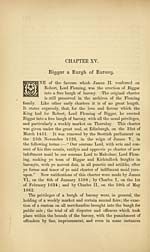Biggar and the House of Fleming
(363) Page 345
Download files
Complete book:
Individual page:
Thumbnail gallery: Grid view | List view

BIGGAR A BURGH OF BARONY. 333
by death ; and, lastly, the recovery of the baron's mails, duties,
profits, multures, and mill service.
It is a popular tradition, that the burgh of Biggar, at one time,
possessed the power of self-government ; and that it was thus,
in point of jurisdiction, similar to a royal burgh, or a burgh of
regality. This power, it is said, was taken away by the in-
fluence or active interference of a lawyer in Edinburgh, who in
his youth had been a vagrant, and who, on account of some
depredation committed at Biggar, had been rather roughly
handled by the authorities and the inhabitants. The following
rhyme is understood to have a reference to this transaction,
from which it would seem that the individual in question had
been drummed out of the town : — ■
" The laddie had tricks that cost him fu' dear,
For he was a runnagait loon ;
But their ain licks and their am drumsticks
Hae fared as ill for the toun."
No written proof exists, so far as we know, to lend anything
like confirmation to this tradition, though it is by no means
unlikely that the Flemings, for services performed, conferred
extra privileges on the burgh, and that some incident occurred
which caused these privileges to be taken away. It is evident,
however, that the Flemings treated the inhabitants of Biggar
with considerable liberality. The whole land in the immediate
neighbourhood of the town was conferred on the burgh, and
was divided into twenty-four portions, called Burgh or Borrow
lands ; and besides these, there were also two Cotlands. A
burgh land was of sufficient extent to allow one or two houses
to be erected on it, fronting the street, and to afford ample
space for a garden and a croft. The possessors of these burgh
lands, who, both in common parlance and in legal documents,
were styled burgesses, had each of them a right to a piece of
land, on the east of the town, called the Borrow Muir, on
which they raised crops and pastured their cattle, and had,
besides, a " darg " or " room " in one of the mosses in the
neighbourhood of the town, from which they drew large supplies
of peats and divots, or, as they are generally called roughheads.
The burgh lands were not all of the same extent. They ranged
from five to eight acres, and each of them was valued at L.12,
by death ; and, lastly, the recovery of the baron's mails, duties,
profits, multures, and mill service.
It is a popular tradition, that the burgh of Biggar, at one time,
possessed the power of self-government ; and that it was thus,
in point of jurisdiction, similar to a royal burgh, or a burgh of
regality. This power, it is said, was taken away by the in-
fluence or active interference of a lawyer in Edinburgh, who in
his youth had been a vagrant, and who, on account of some
depredation committed at Biggar, had been rather roughly
handled by the authorities and the inhabitants. The following
rhyme is understood to have a reference to this transaction,
from which it would seem that the individual in question had
been drummed out of the town : — ■
" The laddie had tricks that cost him fu' dear,
For he was a runnagait loon ;
But their ain licks and their am drumsticks
Hae fared as ill for the toun."
No written proof exists, so far as we know, to lend anything
like confirmation to this tradition, though it is by no means
unlikely that the Flemings, for services performed, conferred
extra privileges on the burgh, and that some incident occurred
which caused these privileges to be taken away. It is evident,
however, that the Flemings treated the inhabitants of Biggar
with considerable liberality. The whole land in the immediate
neighbourhood of the town was conferred on the burgh, and
was divided into twenty-four portions, called Burgh or Borrow
lands ; and besides these, there were also two Cotlands. A
burgh land was of sufficient extent to allow one or two houses
to be erected on it, fronting the street, and to afford ample
space for a garden and a croft. The possessors of these burgh
lands, who, both in common parlance and in legal documents,
were styled burgesses, had each of them a right to a piece of
land, on the east of the town, called the Borrow Muir, on
which they raised crops and pastured their cattle, and had,
besides, a " darg " or " room " in one of the mosses in the
neighbourhood of the town, from which they drew large supplies
of peats and divots, or, as they are generally called roughheads.
The burgh lands were not all of the same extent. They ranged
from five to eight acres, and each of them was valued at L.12,
Set display mode to:
![]() Universal Viewer |
Universal Viewer | ![]() Mirador |
Large image | Transcription
Mirador |
Large image | Transcription
Images and transcriptions on this page, including medium image downloads, may be used under the Creative Commons Attribution 4.0 International Licence unless otherwise stated. ![]()
| Histories of Scottish families > Biggar and the House of Fleming > (363) Page 345 |
|---|
| Permanent URL | https://digital.nls.uk/94843638 |
|---|
| Description | A selection of almost 400 printed items relating to the history of Scottish families, mostly dating from the 19th and early 20th centuries. Includes memoirs, genealogies and clan histories, with a few produced by emigrant families. The earliest family history goes back to AD 916. |
|---|

